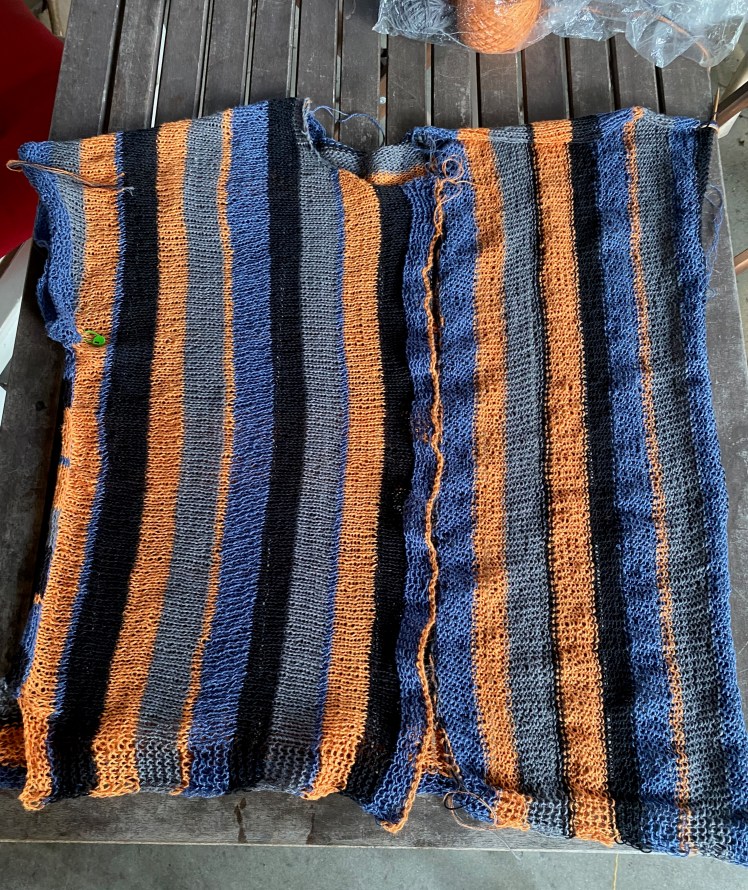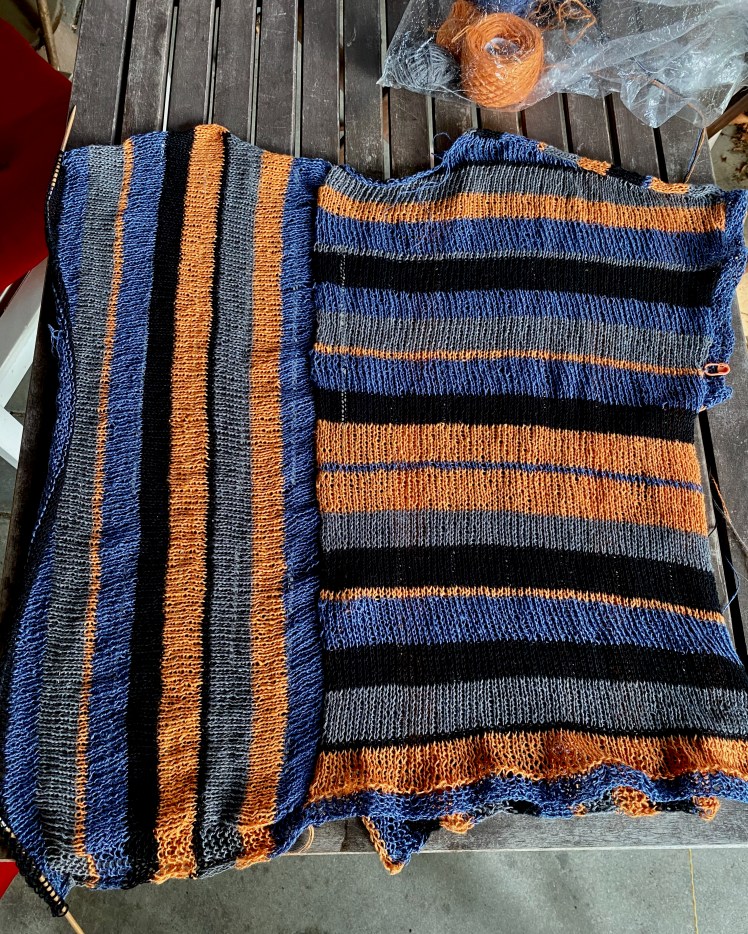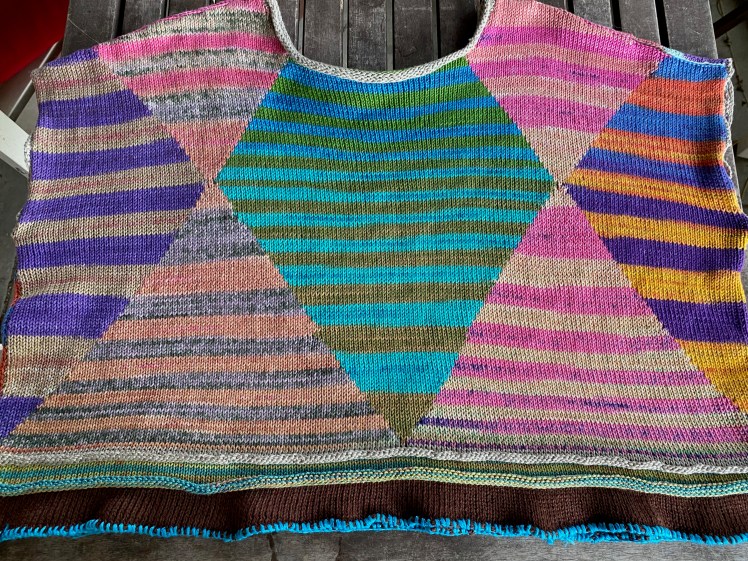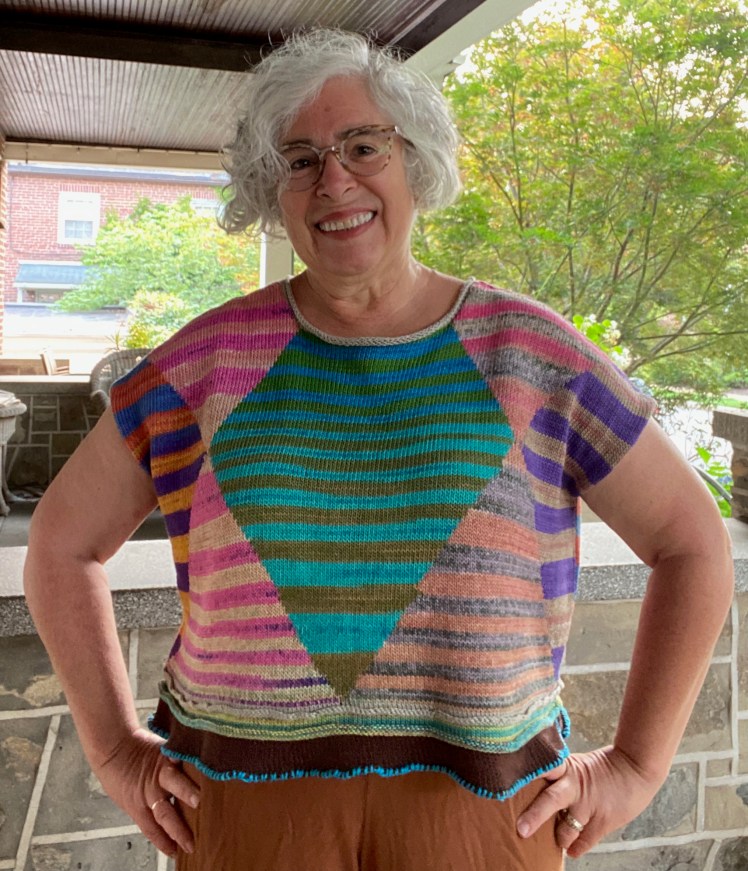Monogamy has a specific meaning in knitter jargon: it means working on one project at a time until the project is finished. Before I retired, I was a monogamous knitter, and it was satisfying to me to focus all my thought and knitting time on the project and seeing it steadily grow. Then I retired and got a knitting machine and became bigamous, one project upstairs on the knitting machine, not movable until I got to the finishing stage, and another handknitted or crocheted project that I could stuff into a bag and carry to the yarn store or work on it from the living room couch while I watched Rachel Maddow. That was two separate families, but now I had more time to dedicate to making things, so neither the projects or I complained.
But these last few months, I have crossed the line into polygamy. I have had four projects going all at once, and it’s frustrating because it’s too hectic and it takes way too long to finish anything. It wasn’t intentional, I didn’t mean to cheat on the projects that were already in progress when I started something new, it just happened, as unfaithful spouses are wont to say. It was just a matter of timing. They weren’t supposed to bunch up all at the same time, but things take a long time when your attention is scattered. The slowest of the projects is something I started almost a year ago as a birthday present for my younger daughter, and I wildly underestimated how much work it would be. It’s a machine-knit blanket with machine-knit appliqués and machine-knit fringes, so how long can it take? Almost a year later, I know the answer is, it’s going to take a year, and only if I focus monogamously on it in the last six weeks before the next birthday. The issue is that it’s a fully reversible blanket, with no wrong side. The appliqué motifs are embroidered by hand so that the stitching that affixes the appliqué on one side is a design element on the other side, and all of the ends will be embroidered so that they show equally on both sides. It’s a massive endeavor that has been sidelined many times when other projects became more immediate priorities. It’s too bulky and heavy to be portable, which limits where and when I can work on it, but I work on it, even if it’s just a few stitches at a time a couple of times a week.

The next project that contributed to this polygamous pile-up is a KAL (knit-along) that I’m doing with Melissa. Last year I became so entranced by a pair of elaborately patterned stranded pants that I couldn’t rest until I got the book in which it was published, Hurmaavat Hameet, Valloittavat Villahousut by Hanne Piirainene and Jaana Jokela, even though it’s in Finnish and I don’t know Finnish. I showed the book to Melissa and she fell in love with it too. She fixated on a pair of cabled and bobbled leggings, so I got her a copy as a birthday present, and we agreed that we would each knit our favorite patterns together. Melissa has done all the translation work with Google lens and has sped ahead with her pants. I also have used Google lens to translate my pattern, but patterns written in native English are hard enough for me to understand, so Melissa has had to translate the translations for me. But I love the charts, and complicated stranded knitting is my happy place, but now it’s summer and I have to make summer tops, so I’m only now approaching the crotch while Melissa is working on her second leg. When I finally finish the summer knitting, I will be able to forge ahead with my pants.

Summer is my least favorite season because of the heat and humidity, and most of the things I have knitted for summer are too hot and sticky to wear. But I have hopes for this summer’s knitted tops because of the yarn I’m using and the roominess of the garments. I chose the two projects based on the yarn I had on hand, one of them using five skeins of Uneek Cotton DK self-striping yarn that I’ve had sitting around for years. I started thinking about using this yarn in machine-knit intarsia back in January, when I experimented with the intarsia carriage that my knitting fairy godmother, Rebecca Yaker, gave me last summer. The other summer top project uses four colors of very thin hemp yarn that Melissa gave me when a customer’s husband unloaded his late wife’s stash on her after she died last spring. For that, I’m using a pattern that came out during the spring, Dinner With My Captain, by Hinterm Stein.
I was attracted to that pattern because it has a modular construction of striped pieces alternating between knitting the stripes horizontally, the usual way, and knitting side-to-side, forming vertical stripes lengthwise up and down the body. I’m very interested in the numbers for shaping shoulders and necks in fabrics knitted both horizontally and vertically because these modular constructions expand the size range on knitting machines beyond the range of my 200-needle standard gauge knitting machine, in a visually interesting way.
My original intention was to use the pattern’s numbers for a machine-knit interpretation of the pattern, but when I started reading through the pattern, the instructions were much more complicated than I was expecting, and the designer had used techniques that I wasn’t familiar with. It looked like a lot to try to sort out, since I’m not very good at understanding pattern instructions until I actually have the knitting in front of me and can absorb the formulaic concepts by applying the instructions at the stitch-by-stitch granular level. So I decided to knit the garment by hand, even though I generally don’t enjoy knitting plain stockinette by hand. It’s actually not as deadly as it might be, because the striping sequence changes colors before bored paralysis sets in, and the shaping requires alertness. It’s a very slow slog, and I have worries that my yarn’s tendency to stretch widthwise is going to cause sagging and buckling at the seams that isn’t going to work out in the finishing. I have bought yarn for machine-knit interpretations for my two daughters and myself, and I’m pretty confident that I won’t have gauge problems with that yarn.


But as for the machine-knit intarsia top, I have actually finished it! My intarsia carriage came with five sinkers that have holes into which the ends of the yarn are threaded, and the sinkers help to give weight to the separate threads of the intarsia that give the yarn the tension it needs to stay on the needles. They also to help keep the threads from tangling with each other. That had been a huge problem in my previous experiments with machine-knit intarsia, so I am thrilled that the sinkers are such a simple and effective solution to the problem. Now I just need another twenty of them! I’m also an enthusiastic convert to the intarsia carriage itself, because it seems to keep the position of the latches in the proper place much better than the intarsia cam on the K-carriage does, as long as the latches are open and the stitches are behind the latches. I found that running the smooth side of a needle pusher through the ends of the needles was a very effective way to make sure that the latches were open. I got better at the mechanics of using the carriage with experience, and eventually I was able to do this fiddly operation relatively efficiently.
I didn’t want to attempt too complicated an intarsia design for my first garment using the technique, so I devised a simple plan to create large diamonds that were shaped every other row. Along with my five sinkers, I had five Uneek Cotton colorways that I arranged to emphasize their differences, although I can’t really predict how their dye patterns will distribute the colors. The one skein that was distinctly different from the others was the mostly blue and green one, so that one went into the center. I had a partly used skein with a lot of purple, so that one went onto the side as a half motif, which needed less yarn. I had another skein that also had a good bit of purple, so that one went onto the other side. The other two skeins had a greater preponderance of lighter colors than the others, so those framed the more contrastive center and side motifs. That was the extent of my planning, and from there I just knitted the shapes and let the yarn do what it wanted to do.
The garment is a wide rectangle with short row shoulder shaping every inch. My stitch gauge was 6 stitches/inch, so the short rows were placed six stitches apart until I got to the remaining stitches at the neck. I started the neck shaping at the same row as the start of the shoulder shaping, which worked out to 35 stitches at the center, two stitches at either end short-rowed every other row, and three stitches at either end short-rowed every four rows. I did the same shaping on both sides, so the garment doesn’t have an assigned front and back. As long as it’s right-side-out, I can throw it on and wear it however it lands. The one big mistake I made was underestimating how much length I needed for the body, and it was short by a couple of inches. The original hem edging was a reverse stockinette curl, to which I added a couple of afterthought hems until I got to the right length. I picked up stitches four rows from the edge of the original curled hem so that it would continue to curl, knitted 12 rows, and bound off. Then I picked up stitches for the final afterthought hem four rows from the edge of the second hem and knitted another 12 rows, then bound off. That last hem had to lie flat because I needed its full length, so I borrowed an idea from the Hana pattern and blanket-stitched it in a contrast color. It lies pretty flat, and the top is finally the length I had in mind.






Now my polygamous pile-up is down by one, so I’m giving more time to the other three pending projects. It will be such a relief to finish the other summer top so that I can get back to mere bigamy. Polygamy is exhausting!

Congrats on being able to manage multiple projects. In general I like to have 2 or 3 going but not more than 5. I get anxious as I find it hard to pick up a project I haven’t worked on for a while. You have many beautiful projects.
LikeLike
Thank you! I just want to get these projects done. And yet I’m winding yarn for another summer top that I’ll probably start while continuing to work on the blanket and pants, to get it done while it’s still summer. The hamster wheel is speeding up, not slowing down.
LikeLiked by 1 person
Your diamonds top is absolutely great! I can’t imagine being able to design like that, it looks fantastic.
LikeLike